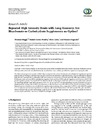Please use this identifier to cite or link to this item:
https://accedacris.ulpgc.es/jspui/handle/10553/47360
| DC Field | Value | Language |
|---|---|---|
| dc.contributor.author | Stöggl, Thomas | en_US |
| dc.contributor.author | Torres-Peralta, Rafael | en_US |
| dc.contributor.author | Cetin, Ebru | en_US |
| dc.contributor.author | Nagasaki, Masaru | en_US |
| dc.date.accessioned | 2018-11-23T12:56:19Z | - |
| dc.date.available | 2018-11-23T12:56:19Z | - |
| dc.date.issued | 2014 | en_US |
| dc.identifier.issn | 2356-6140 | en_US |
| dc.identifier.uri | https://accedacris.ulpgc.es/handle/10553/47360 | - |
| dc.description.abstract | The effects of varying recovery modes and the influence of preexercise sodium bicarbonate and carbohydrate ingestion on repeated high intensity performance, acid-base response, and recovery were analyzed in 12 well-trained males. They completed three repeated high intensity running bouts to exhaustion with intervening recovery periods of 25 min under the following conditions: sodium bicarbonate, active recovery (BIC); carbohydrate ingestion, active recovery (CHO); placebo ingestion, active recovery (ACTIVE); placebo ingestion, passive recovery (PASSIVE). Blood lactate (BLa), blood gases, heart rate, and time to exhaustion were collected. The three high intensity bouts had a duration of , and s demonstrating a decrease from bout 1 to bout 3. Supplementation strategy had no effect on performance in the first bout, even with differences in pH and bicarbonate (HC). Repeated sprint performance was not affected by supplementation strategy when compared to ACTIVE, while PASSIVE resulted in a more pronounced decrease in performance compared with all other interventions. BIC led to greater BLa, pH, and HC values compared with all other interventions, while for PASSIVE the opposite was found. BLa recovery was lowest in PASSIVE; recovery in pH, and HC was lower in PASSIVE and higher in BIC. | en_US |
| dc.language | eng | en_US |
| dc.publisher | 2356-6140 | - |
| dc.relation.ispartof | The Scientific World Journal | en_US |
| dc.source | Scientific World Journal[ISSN 2356-6140],v. 2014 (145747) | en_US |
| dc.subject | 241106 Fisiología del ejercicio | en_US |
| dc.title | Repeated high intensity bouts with long recovery: Are bicarbonate or carbohydrate supplements an option? | en_US |
| dc.type | info:eu-repo/semantics/Article | es |
| dc.type | Article | es |
| dc.identifier.doi | 10.1155/2014/145747 | |
| dc.identifier.scopus | 84912570967 | - |
| dc.contributor.authorscopusid | 56394691600 | - |
| dc.contributor.authorscopusid | 56431163500 | - |
| dc.contributor.authorscopusid | 7006717241 | - |
| dc.contributor.authorscopusid | 7005461975 | - |
| dc.identifier.issue | 145747 | - |
| dc.relation.volume | 2014 | - |
| dc.investigacion | Ciencias de la Salud | en_US |
| dc.type2 | Artículo | en_US |
| dc.date.coverdate | Enero 2014 | |
| dc.identifier.ulpgc | Sí | es |
| item.grantfulltext | open | - |
| item.fulltext | Con texto completo | - |
| crisitem.author.dept | GIR IUIBS: Rendimiento humano, ejercicio físico y salud | - |
| crisitem.author.dept | IU de Investigaciones Biomédicas y Sanitarias | - |
| crisitem.author.orcid | 0000-0002-0848-4260 | - |
| crisitem.author.parentorg | IU de Investigaciones Biomédicas y Sanitarias | - |
| crisitem.author.fullName | Sanchez De Torres Peralta,Rafael | - |
| Appears in Collections: | Artículos | |
SCOPUSTM
Citations
10
checked on Jun 8, 2025
Page view(s)
125
checked on Nov 1, 2024
Download(s)
121
checked on Nov 1, 2024
Google ScholarTM
Check
Altmetric
Share
Export metadata
Items in accedaCRIS are protected by copyright, with all rights reserved, unless otherwise indicated.
